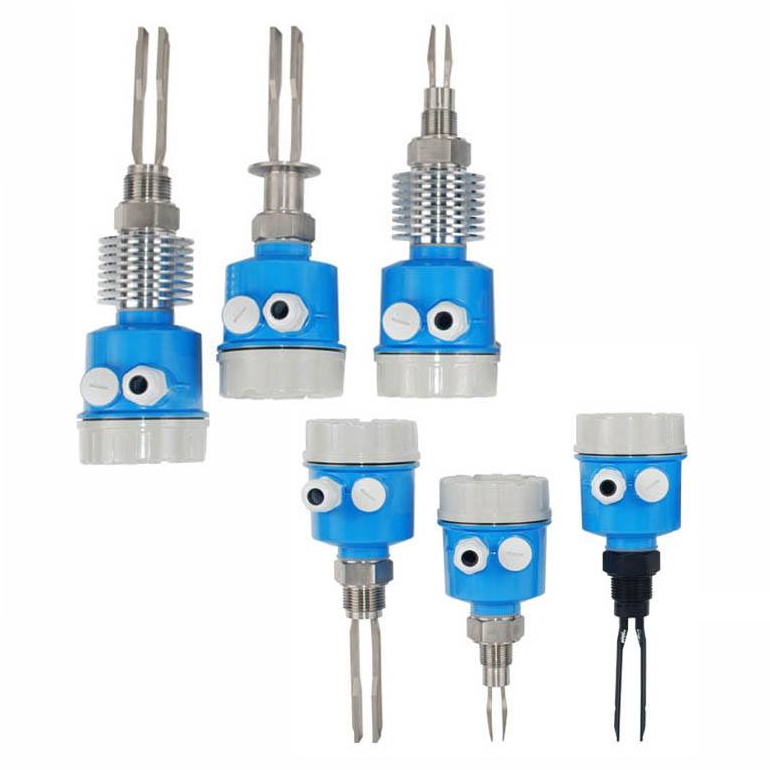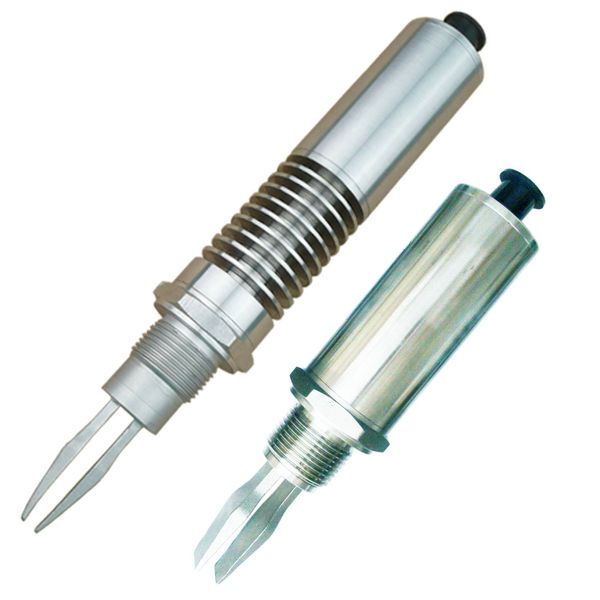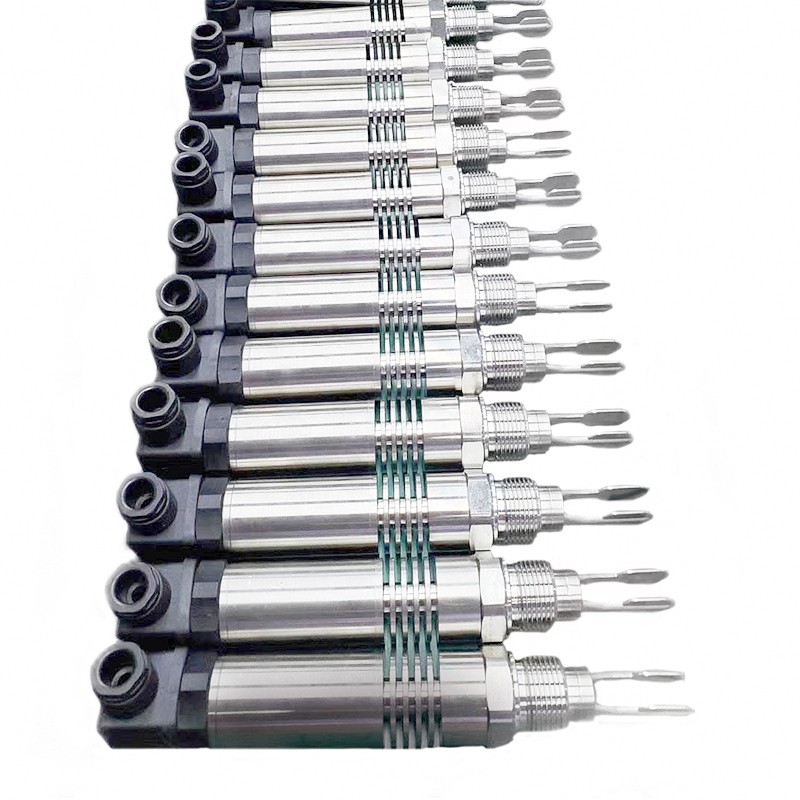BETTER TOUCH BETTER BUSINESS
Contact Sales at KAIDI.
The tuning fork level sensor is a level measuring instrument based on the vibration principle of the cantilever beam, using the tuning fork as the vibration probe, and using the piezoelectric device to realize the drive and detection of the vibration of the fork body. When the tuning fork is not in contact with the material, the tuning fork will vibrate freely at the resonant frequency. When the tuning fork is in contact with the material to be tested, the vibration amplitude of the tuning fork will be significantly reduced, and the output signal amplitude of the piezoelectric tuning fork level detection device will decrease accordingly. The signal change is detected by the intelligent circuit. Analyze and output a switching signal. It is a solid level switch specially used to measure powder and fine particles. It can measure fine sand, fine chemical raw materials, flour, salt and other materials. It is especially suitable for ultra-low density material level measurement, with wide adaptability and high reliability. .
However, due to the complex situation on site and the large difference in working conditions, the user needs to select the corresponding type of tuning fork level switch according to the characteristics of their own working conditions and specific needs when actually purchasing. In order to help users better use the tuning fork level switch, this article focuses on how to correctly select and use the tuning fork level switch.

Under normal circumstances, users need to pay attention to the following points when making the selection of the tuning fork level switch:
1. Connection method: The common process connection methods of the tuning fork level switch include flange connection, threaded connection and clamp connection. In specific applications, the connection method should be determined according to the requirements of the site conditions.
2. Output mode: The output mode of the tuning fork level switch includes relay, two-wire system, PNP or NAMUR, among which the relay output mode is the most common. The user should make a reasonable selection based on the requirements of the on-site working conditions and fully communicate with the manufacturer.
3. Insertion depth: The determination of the insertion depth is directly related to the selection of the length of the probe. The user should fully consider the wall thickness of the on-site tank or the height of the riser to select the type to avoid the probe being too long or too short, because too long will increase the use of Cost, if it is too short, it will not be able to contact the material, so that it cannot be measured normally.
4. Flammable and explosive: When selecting models, it should also be confirmed whether the site is inflammable and explosive. Dust explosion proof). If there is no flammable and explosive danger, there is no need to choose a tuning fork level switch for solids with explosion-proof function.
5. Sealing requirements: If the dust or water vapor on site is large, under severe working conditions, it is best to choose a tuning fork level switch working principle product with better sealing and higher protection level.
6. Shock resistance requirements: The materials in the silo usually have a hollow "bridge" phenomenon inside, forming a false material level. In view of this situation, users often use the method of hitting the warehouse wall to eliminate it in the actual operation process, which objectively puts forward requirements for the shock resistance of the tuning fork level switch. Therefore, when selecting a model, a tuning fork with good shock resistance should be selected. Level switch.
7. Medium density: At present, most of the tuning fork level switches on the market measure both the material level and the liquid level, which greatly reduces the sensitivity of its measurement and is incompetent for the measurement of some lower density media. Jiwei Fork-11 Tuning Fork Level Switch is a tuning fork level switch specially used for material level measurement. This product increases the fork body area reasonably, and the fork body is precisely tuned to greatly improve the sensitivity, and the measured material density is as low as 0.008 g/cm³. Therefore, when selecting models, you should also pay attention to the minimum density of the medium that can be detected by the selected instrument to avoid failure to measure.

It is a prerequisite for users to accurately measure the material level in practical applications, and it is a prerequisite to purchase an instrument with excellent quality and matching working conditions, but to maximize the function of the instrument, it is also inseparable from correct operation and standardized use. must. In practical applications, the following points should also be noted:
1. The tuning fork level switch is often installed by top or side installation. The specific installation method should be determined according to the characteristics of the site conditions and measurement requirements.
2. During the material level measurement process, the material surface changes dynamically. For example, when feeding, the material surface is convex; when discharging, the material surface is concave. Therefore, in order to accurately measure the material level, it is required to install the tuning fork level switch on the average position of the material level.
3. Materials will accumulate in the dead corner of the silo and cannot be emptied. In order to avoid affecting the normal measurement of the instrument, the tuning fork level switch shall not be installed in the dead corner of the silo.
4. When feeding or unloading, the movement of the material will cause friction or impact on the tuning fork level switch installed in the silo, especially for block materials. Therefore, the material of the tuning fork level switch should be wear-resistant, and the structure should have sufficient strength. At the same time, pay attention not to install the tuning fork material level switch directly below the material inlet and above the material outlet, so as to avoid excessive impact.
5. When measuring and controlling the lower limit material level, the tuning fork material level switch should be installed at the bottom of the container. But when the silo is full, because the tuning fork level switch has to bear the huge pressure of the material, it is easy to be damaged. Therefore, certain measures should be taken in structure, and it cannot be installed as simply as when controlling the upper limit material level, such as dispersing the pressure of the material in the full silo to the baffle or the silo wall to effectively protect the lower limit control. The tuning fork material level switch.
6. When the tuning fork level switch is installed on the wall of the silo, if the connection part is not handled properly, it will often cause condensation or material adhesion, which will lead to false alarms. Therefore, when installing the tuning fork level switch, attention should be paid to the relevant processing work.
7. When using the tuning fork level switch, try to avoid mixing long-fiber materials, so as not to entangle the tuning fork and cause malfunction. If there is already long fiber entanglement, it should be dealt with in time.

We are here to help you! If you close the chatbox, you will automatically receive a response from us via email. Please be sure to leave your contact details so that we can better assist